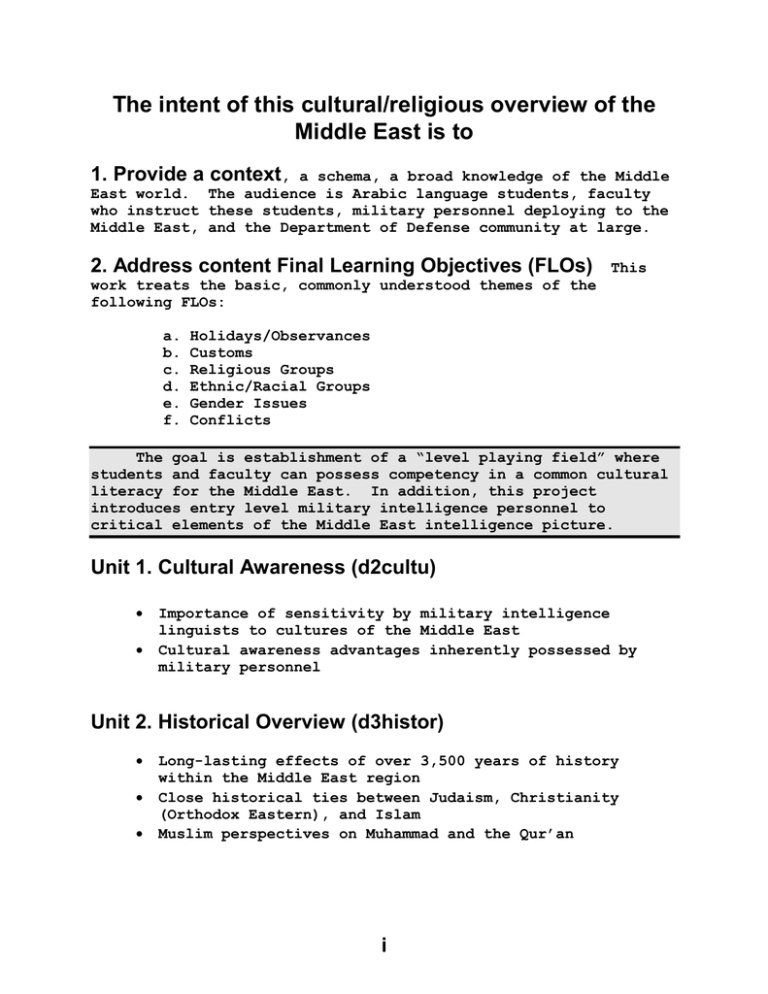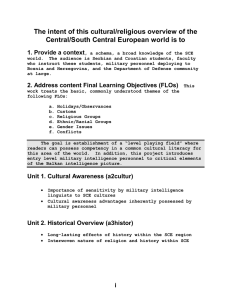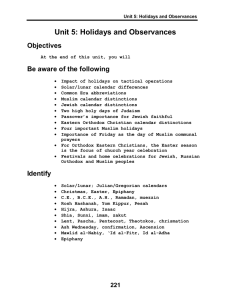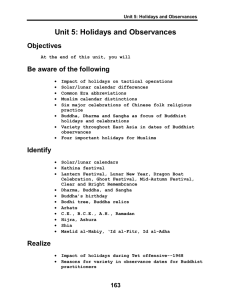The intent of this cultural/religious overview of the
advertisement

The intent of this cultural/religious overview of the Middle East is to 1. Provide a context, a schema, a broad knowledge of the Middle East world. The audience is Arabic language students, faculty who instruct these students, military personnel deploying to the Middle East, and the Department of Defense community at large. 2. Address content Final Learning Objectives (FLOs) This work treats the basic, commonly understood themes of the following FLOs: a. b. c. d. e. f. Holidays/Observances Customs Religious Groups Ethnic/Racial Groups Gender Issues Conflicts The goal is establishment of a “level playing field” where students and faculty can possess competency in a common cultural literacy for the Middle East. In addition, this project introduces entry level military intelligence personnel to critical elements of the Middle East intelligence picture. Unit 1. Cultural Awareness (d2cultu) • Importance of sensitivity by military intelligence linguists to cultures of the Middle East • Cultural awareness advantages inherently possessed by military personnel Unit 2. Historical Overview (d3histor) • Long-lasting effects of over 3,500 years of history within the Middle East region • Close historical ties between Judaism, Christianity (Orthodox Eastern), and Islam • Muslim perspectives on Muhammad and the Qur’an i Unit 3. Foundational Beliefs (d4belief) • Distinguishing tenets of Judaism, Christianity (Orthodox Eastern) and Islam • Lesser and Greater Jihad Unit 4. Gestures and Taboos (d5gestur) • Foundational principles to apply when interacting with a new culture • Importance of manner and customs to cultural understanding Unit 5. Holidays and Observances (d6holida) • Distinctive Middle East religious/cultural holidays and observances • Significance of holidays and observances for tactical, operational and strategic military missions Unit 6. Religion and Internal Middle East Politics (d7politi) • Variety and complexity of Middle East Muslim perspectives concerning religion and politics • Diversity of Sharia (Islamic law) found within Middle East societies Unit 7. U.S. Relations--Middle East Cultures (d8usrela) • Principles of United States foreign policy within the Middle East • Recognition that Islam, per se, is not a determining factor in U.S. foreign policy. Rather, the practical doings of Middle East governments and peoples are the focus. Unit 8. Fundamentalisms (d9fundam) • Emotion-laden connotations and manifestations of the term “fundamentalism” • Recognition that extremist fanatical Islamists do not speak for all Muslims ii Unit 9. Selected Middle East Ethnic Groups (e1ethnic) • Variety of ethnic groups throughout the Middle East • Lasting impact of Bedouin/Muslim culture on the whole region Unit 10. Religious Texts--Societal Implications (e2texts) • Ethical practices and views toward violence within Middle East religions • Importance of internal motivation within Islam Unit 11. Gender Issues (e3gender) • Variety of women’s concerns within the Middle East • Close ties between family honor and gender issues Unit 12. Resources (e4resour) • Book, periodical, audio-visual, and electronic (World Wide Web) resources available for further study • Necessity of discernment in dealing with the overwhelming amount of information available on Middle East culture/religion Unit 13. Country Area Studies • Overview of (1) North African [e6nafric], (2) Levant (Israel, Lebanon, Syria--lands bordering the eastern shores of the Mediterranean) [e7levant], (3) Persian Gulf [e8gulf] and (4) Turkish and Afghanistan influences upon the region [e9turkey] • Distinctive Muslim, Jewish and Orthodox Eastern Christian practices within the region • Country locations • General and commonly understood treatment of the following Final Learning Objectives (FLOs) for each country: 1. 2. 3. 4. Holidays/Observances Customs Religious Groups Ethnic/Racial Groups iii 5. Gender Issues 6. Conflicts Objectives: Arab World Manners and Customs Each unit includes the following objectives. grow in their understanding of... Readers will Unit 1. Overview (f4overvi) • Impact of Islam throughout the Middle East • Contrasting views of time: American and Middle Eastern Unit 2. Religion (f5religi) • All pervasive nature of the Sharia • Major Muslim practices and observances Unit 3. Arab Society (f6arabs) • Importance of clan and family in the Middle East • Male/female roles Unit 4. Status (f7status) • Importance of context, status and prestige • “Face” Unit 5. Hospitality and Friendship (f8hospit) • Overarching importance of hospitality in Middle Eastern circles • American/Middle East friendship perceptions Unit 6. Gestures (f9gestur) • Common gestures • Dos and taboos • The “evil eye” iv Unit 7. Concept of Time/Conversation Guidelines (g1time) • Differing American/Middle Eastern perspectives to time • Sensitivities to observe in conversations with Middle Easterners Unit 8. Nuances of Thought (g2nuance) • Importance of context, clan and family in the Middle East • Respect for aesthetic pursuits within Saudi Arabian culture Unit 9. Work and Training Guidelines (g3work) • Perspectives on criticism, competition and comparisons • Work perceptions and practices • Importance of relationships Unit 10. Community and Homelife (g4commun) • Practical considerations when living in Saudi Arabia • Religious morality police • Guidelines for family members, especially women Appendix: Interview with a Middle Easterner (g5append) • Practical applications of manners and customs applied to the training environment • Importance of repetition and rote memory in Middle East circles v











